Online Community Management Report: Lily Christina Bridal Collection
VerifiedAdded on 2022/09/07
|11
|3052
|23
Report
AI Summary
This report delves into the realm of online community development and management, examining the strategies employed by businesses to engage with their target audiences. The report uses the case of Lily Christina – Bridal Collection, analyzing its Instagram presence to illustrate key concepts. It explores various online community models, such as the Virtual Community Model and the Community Model, and discusses the importance of content calendars and audience interaction. The analysis includes an examination of post types, analytics, and user engagement, offering valuable insights into the effectiveness of different content strategies. The report concludes with recommendations for enhancing online community performance, emphasizing the significance of audience engagement, data analysis, and the use of platforms like Instagram to drive business success. The document is contributed by a student to be published on the website Desklib, a platform which provides all the necessary AI based study tools for students.
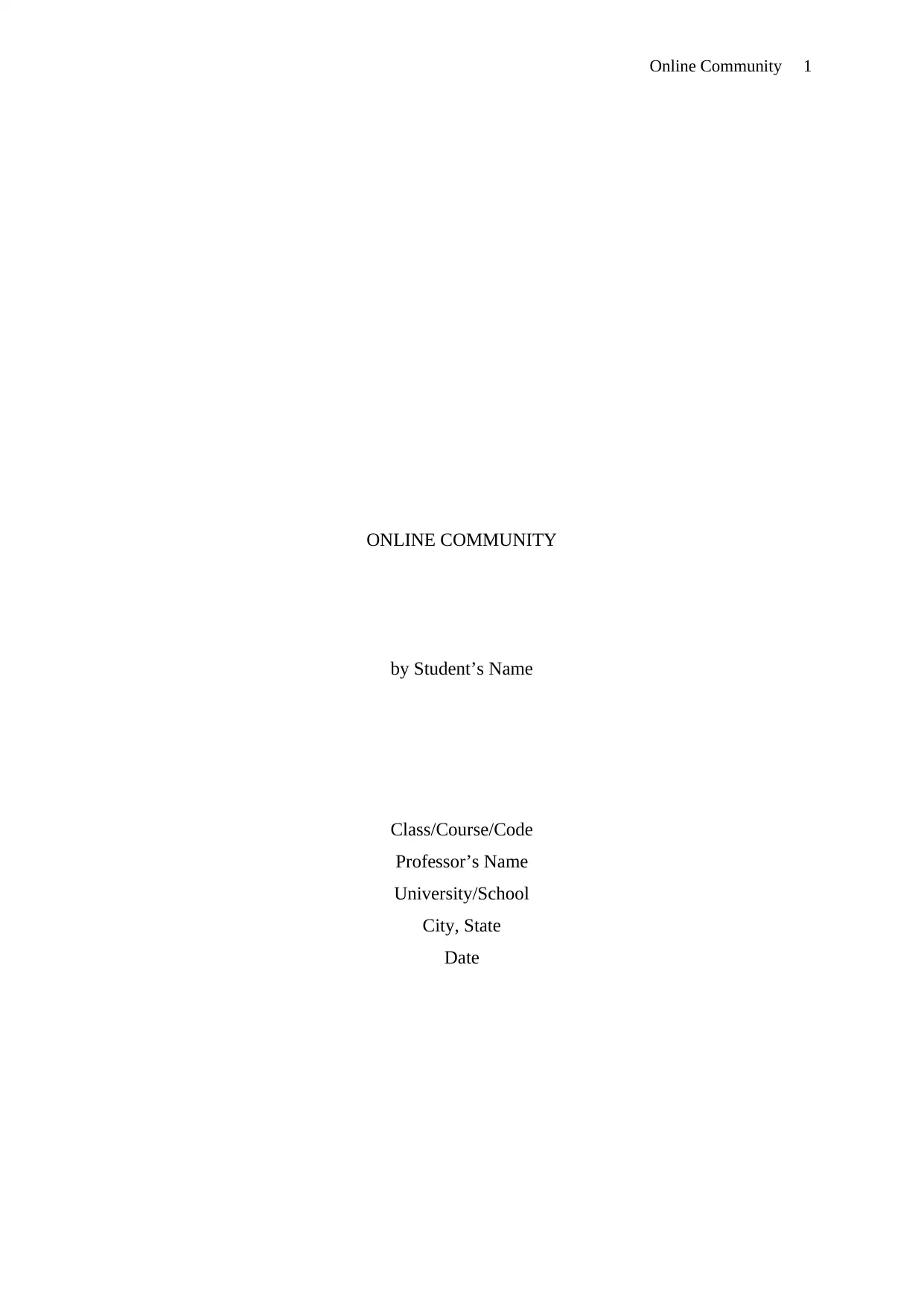
Online Community 1
ONLINE COMMUNITY
by Student’s Name
Class/Course/Code
Professor’s Name
University/School
City, State
Date
ONLINE COMMUNITY
by Student’s Name
Class/Course/Code
Professor’s Name
University/School
City, State
Date
Paraphrase This Document
Need a fresh take? Get an instant paraphrase of this document with our AI Paraphraser
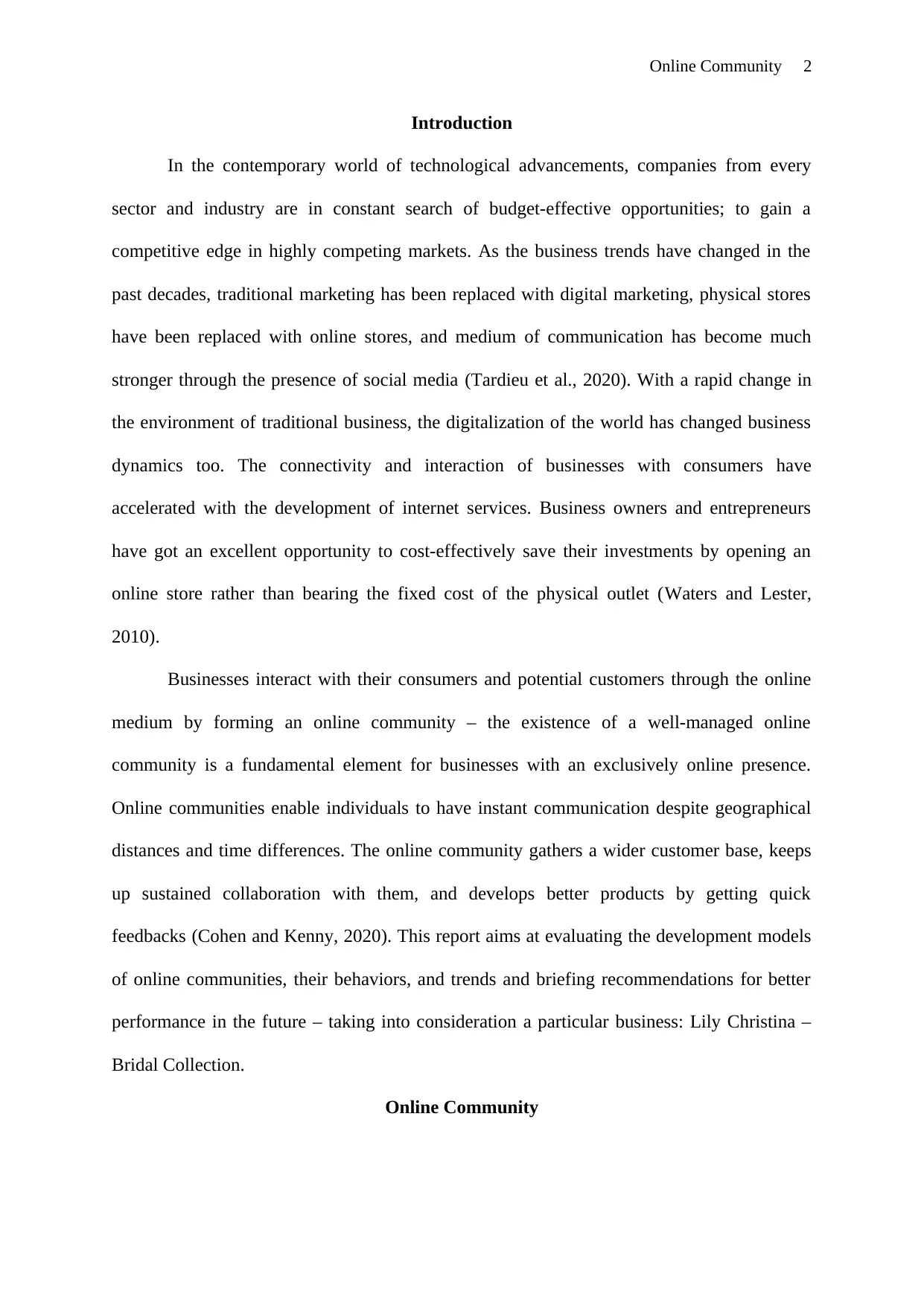
Online Community 2
Introduction
In the contemporary world of technological advancements, companies from every
sector and industry are in constant search of budget-effective opportunities; to gain a
competitive edge in highly competing markets. As the business trends have changed in the
past decades, traditional marketing has been replaced with digital marketing, physical stores
have been replaced with online stores, and medium of communication has become much
stronger through the presence of social media (Tardieu et al., 2020). With a rapid change in
the environment of traditional business, the digitalization of the world has changed business
dynamics too. The connectivity and interaction of businesses with consumers have
accelerated with the development of internet services. Business owners and entrepreneurs
have got an excellent opportunity to cost-effectively save their investments by opening an
online store rather than bearing the fixed cost of the physical outlet (Waters and Lester,
2010).
Businesses interact with their consumers and potential customers through the online
medium by forming an online community – the existence of a well-managed online
community is a fundamental element for businesses with an exclusively online presence.
Online communities enable individuals to have instant communication despite geographical
distances and time differences. The online community gathers a wider customer base, keeps
up sustained collaboration with them, and develops better products by getting quick
feedbacks (Cohen and Kenny, 2020). This report aims at evaluating the development models
of online communities, their behaviors, and trends and briefing recommendations for better
performance in the future – taking into consideration a particular business: Lily Christina –
Bridal Collection.
Online Community
Introduction
In the contemporary world of technological advancements, companies from every
sector and industry are in constant search of budget-effective opportunities; to gain a
competitive edge in highly competing markets. As the business trends have changed in the
past decades, traditional marketing has been replaced with digital marketing, physical stores
have been replaced with online stores, and medium of communication has become much
stronger through the presence of social media (Tardieu et al., 2020). With a rapid change in
the environment of traditional business, the digitalization of the world has changed business
dynamics too. The connectivity and interaction of businesses with consumers have
accelerated with the development of internet services. Business owners and entrepreneurs
have got an excellent opportunity to cost-effectively save their investments by opening an
online store rather than bearing the fixed cost of the physical outlet (Waters and Lester,
2010).
Businesses interact with their consumers and potential customers through the online
medium by forming an online community – the existence of a well-managed online
community is a fundamental element for businesses with an exclusively online presence.
Online communities enable individuals to have instant communication despite geographical
distances and time differences. The online community gathers a wider customer base, keeps
up sustained collaboration with them, and develops better products by getting quick
feedbacks (Cohen and Kenny, 2020). This report aims at evaluating the development models
of online communities, their behaviors, and trends and briefing recommendations for better
performance in the future – taking into consideration a particular business: Lily Christina –
Bridal Collection.
Online Community
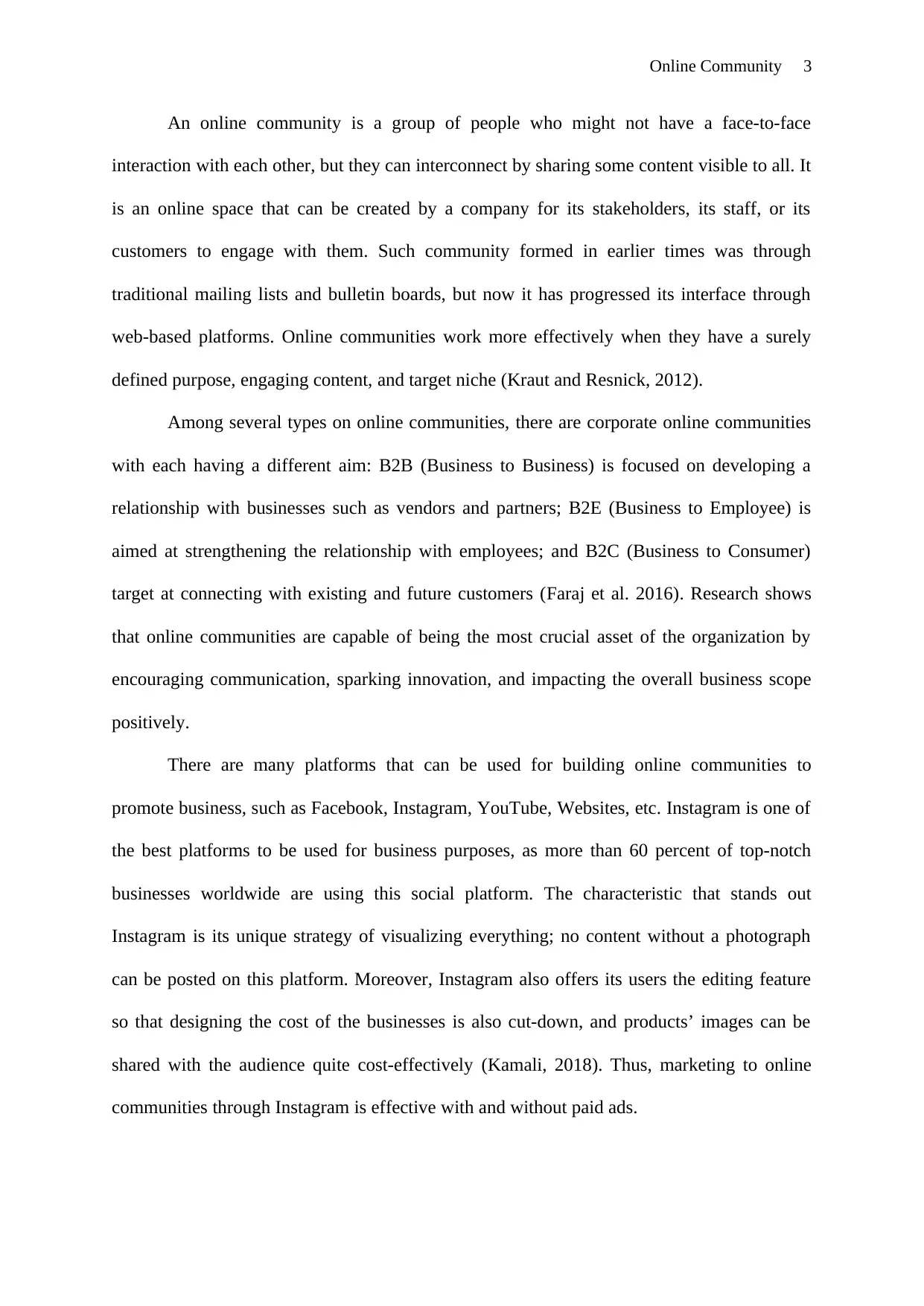
Online Community 3
An online community is a group of people who might not have a face-to-face
interaction with each other, but they can interconnect by sharing some content visible to all. It
is an online space that can be created by a company for its stakeholders, its staff, or its
customers to engage with them. Such community formed in earlier times was through
traditional mailing lists and bulletin boards, but now it has progressed its interface through
web-based platforms. Online communities work more effectively when they have a surely
defined purpose, engaging content, and target niche (Kraut and Resnick, 2012).
Among several types on online communities, there are corporate online communities
with each having a different aim: B2B (Business to Business) is focused on developing a
relationship with businesses such as vendors and partners; B2E (Business to Employee) is
aimed at strengthening the relationship with employees; and B2C (Business to Consumer)
target at connecting with existing and future customers (Faraj et al. 2016). Research shows
that online communities are capable of being the most crucial asset of the organization by
encouraging communication, sparking innovation, and impacting the overall business scope
positively.
There are many platforms that can be used for building online communities to
promote business, such as Facebook, Instagram, YouTube, Websites, etc. Instagram is one of
the best platforms to be used for business purposes, as more than 60 percent of top-notch
businesses worldwide are using this social platform. The characteristic that stands out
Instagram is its unique strategy of visualizing everything; no content without a photograph
can be posted on this platform. Moreover, Instagram also offers its users the editing feature
so that designing the cost of the businesses is also cut-down, and products’ images can be
shared with the audience quite cost-effectively (Kamali, 2018). Thus, marketing to online
communities through Instagram is effective with and without paid ads.
An online community is a group of people who might not have a face-to-face
interaction with each other, but they can interconnect by sharing some content visible to all. It
is an online space that can be created by a company for its stakeholders, its staff, or its
customers to engage with them. Such community formed in earlier times was through
traditional mailing lists and bulletin boards, but now it has progressed its interface through
web-based platforms. Online communities work more effectively when they have a surely
defined purpose, engaging content, and target niche (Kraut and Resnick, 2012).
Among several types on online communities, there are corporate online communities
with each having a different aim: B2B (Business to Business) is focused on developing a
relationship with businesses such as vendors and partners; B2E (Business to Employee) is
aimed at strengthening the relationship with employees; and B2C (Business to Consumer)
target at connecting with existing and future customers (Faraj et al. 2016). Research shows
that online communities are capable of being the most crucial asset of the organization by
encouraging communication, sparking innovation, and impacting the overall business scope
positively.
There are many platforms that can be used for building online communities to
promote business, such as Facebook, Instagram, YouTube, Websites, etc. Instagram is one of
the best platforms to be used for business purposes, as more than 60 percent of top-notch
businesses worldwide are using this social platform. The characteristic that stands out
Instagram is its unique strategy of visualizing everything; no content without a photograph
can be posted on this platform. Moreover, Instagram also offers its users the editing feature
so that designing the cost of the businesses is also cut-down, and products’ images can be
shared with the audience quite cost-effectively (Kamali, 2018). Thus, marketing to online
communities through Instagram is effective with and without paid ads.
⊘ This is a preview!⊘
Do you want full access?
Subscribe today to unlock all pages.

Trusted by 1+ million students worldwide
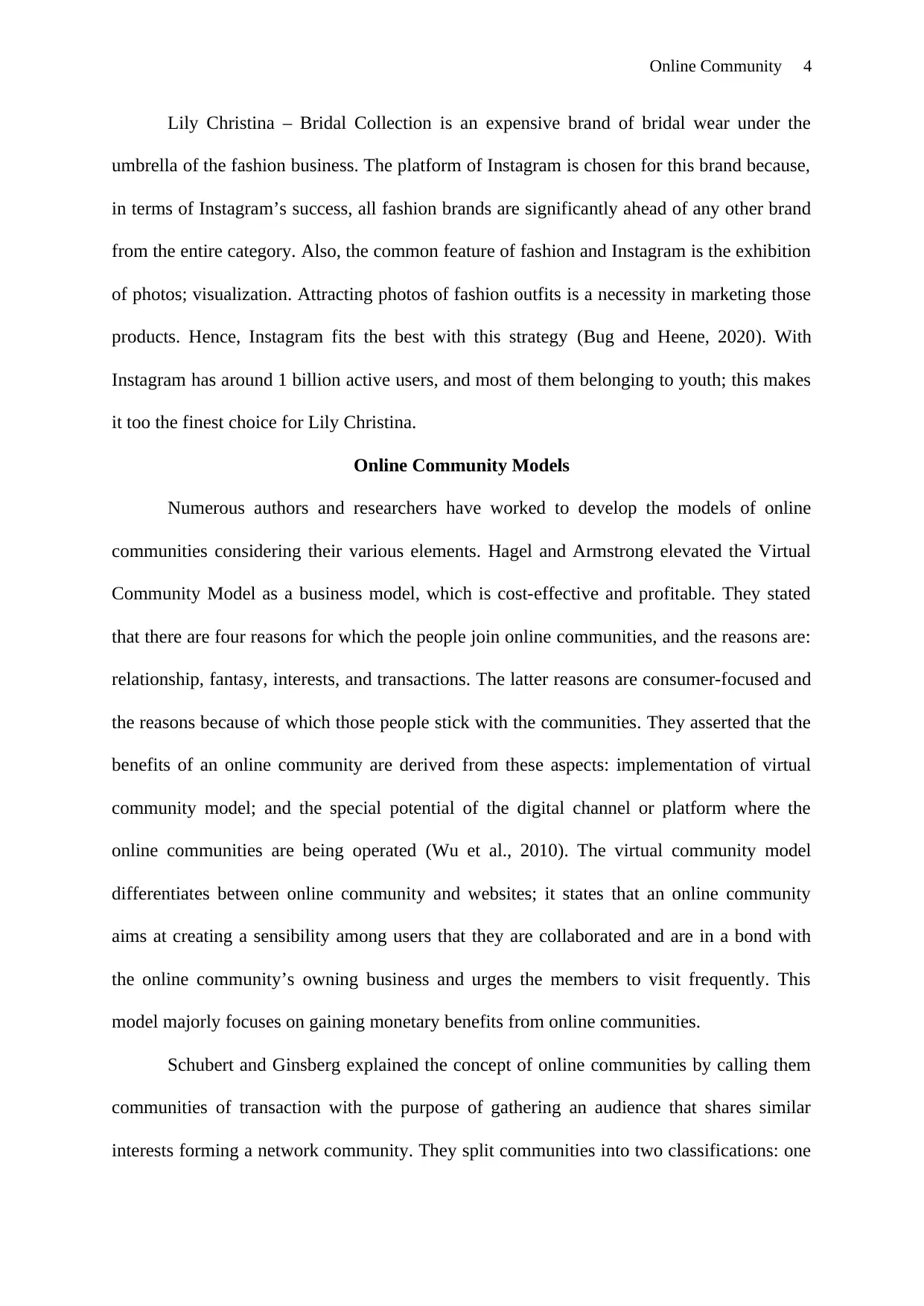
Online Community 4
Lily Christina – Bridal Collection is an expensive brand of bridal wear under the
umbrella of the fashion business. The platform of Instagram is chosen for this brand because,
in terms of Instagram’s success, all fashion brands are significantly ahead of any other brand
from the entire category. Also, the common feature of fashion and Instagram is the exhibition
of photos; visualization. Attracting photos of fashion outfits is a necessity in marketing those
products. Hence, Instagram fits the best with this strategy (Bug and Heene, 2020). With
Instagram has around 1 billion active users, and most of them belonging to youth; this makes
it too the finest choice for Lily Christina.
Online Community Models
Numerous authors and researchers have worked to develop the models of online
communities considering their various elements. Hagel and Armstrong elevated the Virtual
Community Model as a business model, which is cost-effective and profitable. They stated
that there are four reasons for which the people join online communities, and the reasons are:
relationship, fantasy, interests, and transactions. The latter reasons are consumer-focused and
the reasons because of which those people stick with the communities. They asserted that the
benefits of an online community are derived from these aspects: implementation of virtual
community model; and the special potential of the digital channel or platform where the
online communities are being operated (Wu et al., 2010). The virtual community model
differentiates between online community and websites; it states that an online community
aims at creating a sensibility among users that they are collaborated and are in a bond with
the online community’s owning business and urges the members to visit frequently. This
model majorly focuses on gaining monetary benefits from online communities.
Schubert and Ginsberg explained the concept of online communities by calling them
communities of transaction with the purpose of gathering an audience that shares similar
interests forming a network community. They split communities into two classifications: one
Lily Christina – Bridal Collection is an expensive brand of bridal wear under the
umbrella of the fashion business. The platform of Instagram is chosen for this brand because,
in terms of Instagram’s success, all fashion brands are significantly ahead of any other brand
from the entire category. Also, the common feature of fashion and Instagram is the exhibition
of photos; visualization. Attracting photos of fashion outfits is a necessity in marketing those
products. Hence, Instagram fits the best with this strategy (Bug and Heene, 2020). With
Instagram has around 1 billion active users, and most of them belonging to youth; this makes
it too the finest choice for Lily Christina.
Online Community Models
Numerous authors and researchers have worked to develop the models of online
communities considering their various elements. Hagel and Armstrong elevated the Virtual
Community Model as a business model, which is cost-effective and profitable. They stated
that there are four reasons for which the people join online communities, and the reasons are:
relationship, fantasy, interests, and transactions. The latter reasons are consumer-focused and
the reasons because of which those people stick with the communities. They asserted that the
benefits of an online community are derived from these aspects: implementation of virtual
community model; and the special potential of the digital channel or platform where the
online communities are being operated (Wu et al., 2010). The virtual community model
differentiates between online community and websites; it states that an online community
aims at creating a sensibility among users that they are collaborated and are in a bond with
the online community’s owning business and urges the members to visit frequently. This
model majorly focuses on gaining monetary benefits from online communities.
Schubert and Ginsberg explained the concept of online communities by calling them
communities of transaction with the purpose of gathering an audience that shares similar
interests forming a network community. They split communities into two classifications: one
Paraphrase This Document
Need a fresh take? Get an instant paraphrase of this document with our AI Paraphraser
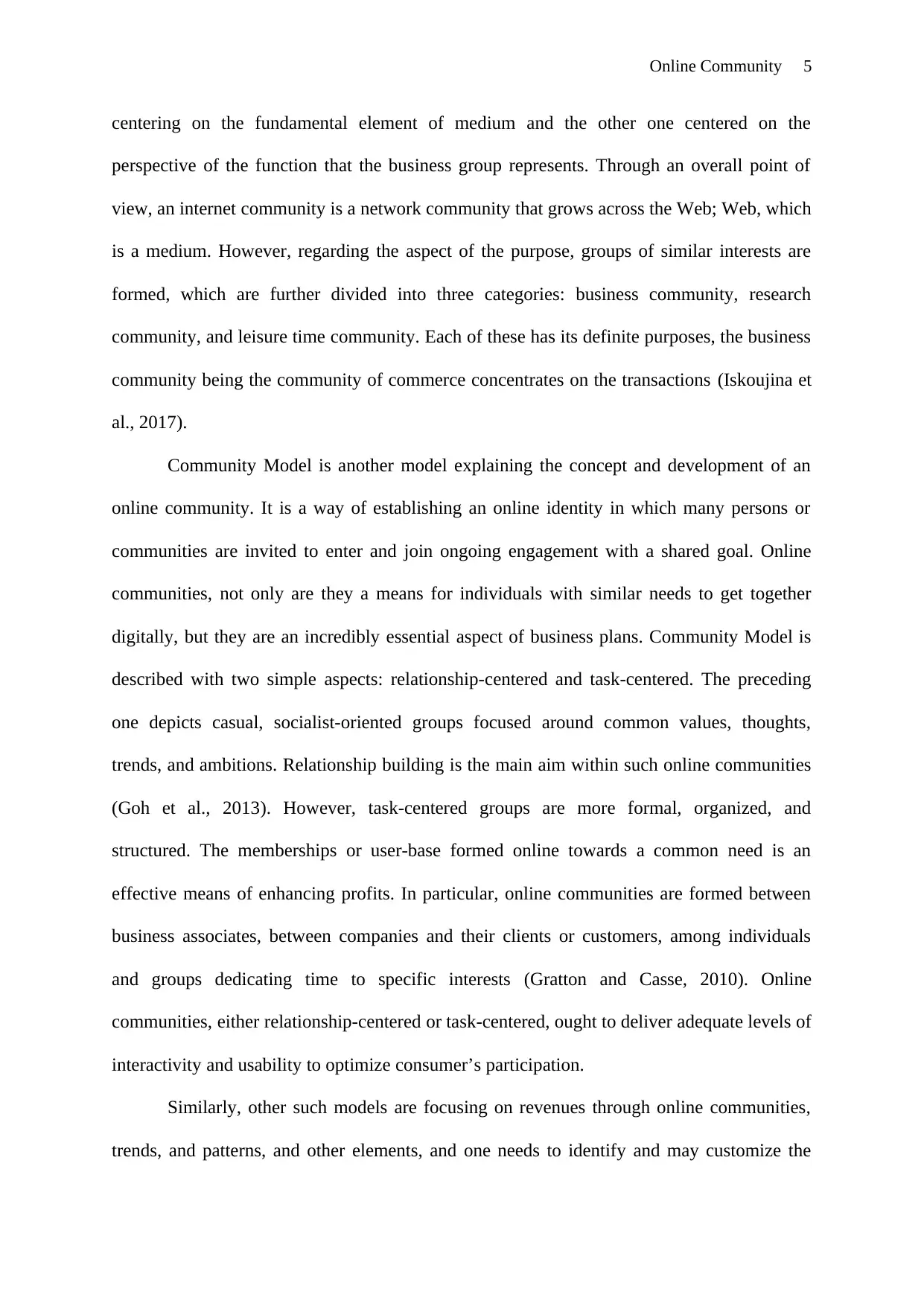
Online Community 5
centering on the fundamental element of medium and the other one centered on the
perspective of the function that the business group represents. Through an overall point of
view, an internet community is a network community that grows across the Web; Web, which
is a medium. However, regarding the aspect of the purpose, groups of similar interests are
formed, which are further divided into three categories: business community, research
community, and leisure time community. Each of these has its definite purposes, the business
community being the community of commerce concentrates on the transactions (Iskoujina et
al., 2017).
Community Model is another model explaining the concept and development of an
online community. It is a way of establishing an online identity in which many persons or
communities are invited to enter and join ongoing engagement with a shared goal. Online
communities, not only are they a means for individuals with similar needs to get together
digitally, but they are an incredibly essential aspect of business plans. Community Model is
described with two simple aspects: relationship-centered and task-centered. The preceding
one depicts casual, socialist-oriented groups focused around common values, thoughts,
trends, and ambitions. Relationship building is the main aim within such online communities
(Goh et al., 2013). However, task-centered groups are more formal, organized, and
structured. The memberships or user-base formed online towards a common need is an
effective means of enhancing profits. In particular, online communities are formed between
business associates, between companies and their clients or customers, among individuals
and groups dedicating time to specific interests (Gratton and Casse, 2010). Online
communities, either relationship-centered or task-centered, ought to deliver adequate levels of
interactivity and usability to optimize consumer’s participation.
Similarly, other such models are focusing on revenues through online communities,
trends, and patterns, and other elements, and one needs to identify and may customize the
centering on the fundamental element of medium and the other one centered on the
perspective of the function that the business group represents. Through an overall point of
view, an internet community is a network community that grows across the Web; Web, which
is a medium. However, regarding the aspect of the purpose, groups of similar interests are
formed, which are further divided into three categories: business community, research
community, and leisure time community. Each of these has its definite purposes, the business
community being the community of commerce concentrates on the transactions (Iskoujina et
al., 2017).
Community Model is another model explaining the concept and development of an
online community. It is a way of establishing an online identity in which many persons or
communities are invited to enter and join ongoing engagement with a shared goal. Online
communities, not only are they a means for individuals with similar needs to get together
digitally, but they are an incredibly essential aspect of business plans. Community Model is
described with two simple aspects: relationship-centered and task-centered. The preceding
one depicts casual, socialist-oriented groups focused around common values, thoughts,
trends, and ambitions. Relationship building is the main aim within such online communities
(Goh et al., 2013). However, task-centered groups are more formal, organized, and
structured. The memberships or user-base formed online towards a common need is an
effective means of enhancing profits. In particular, online communities are formed between
business associates, between companies and their clients or customers, among individuals
and groups dedicating time to specific interests (Gratton and Casse, 2010). Online
communities, either relationship-centered or task-centered, ought to deliver adequate levels of
interactivity and usability to optimize consumer’s participation.
Similarly, other such models are focusing on revenues through online communities,
trends, and patterns, and other elements, and one needs to identify and may customize the
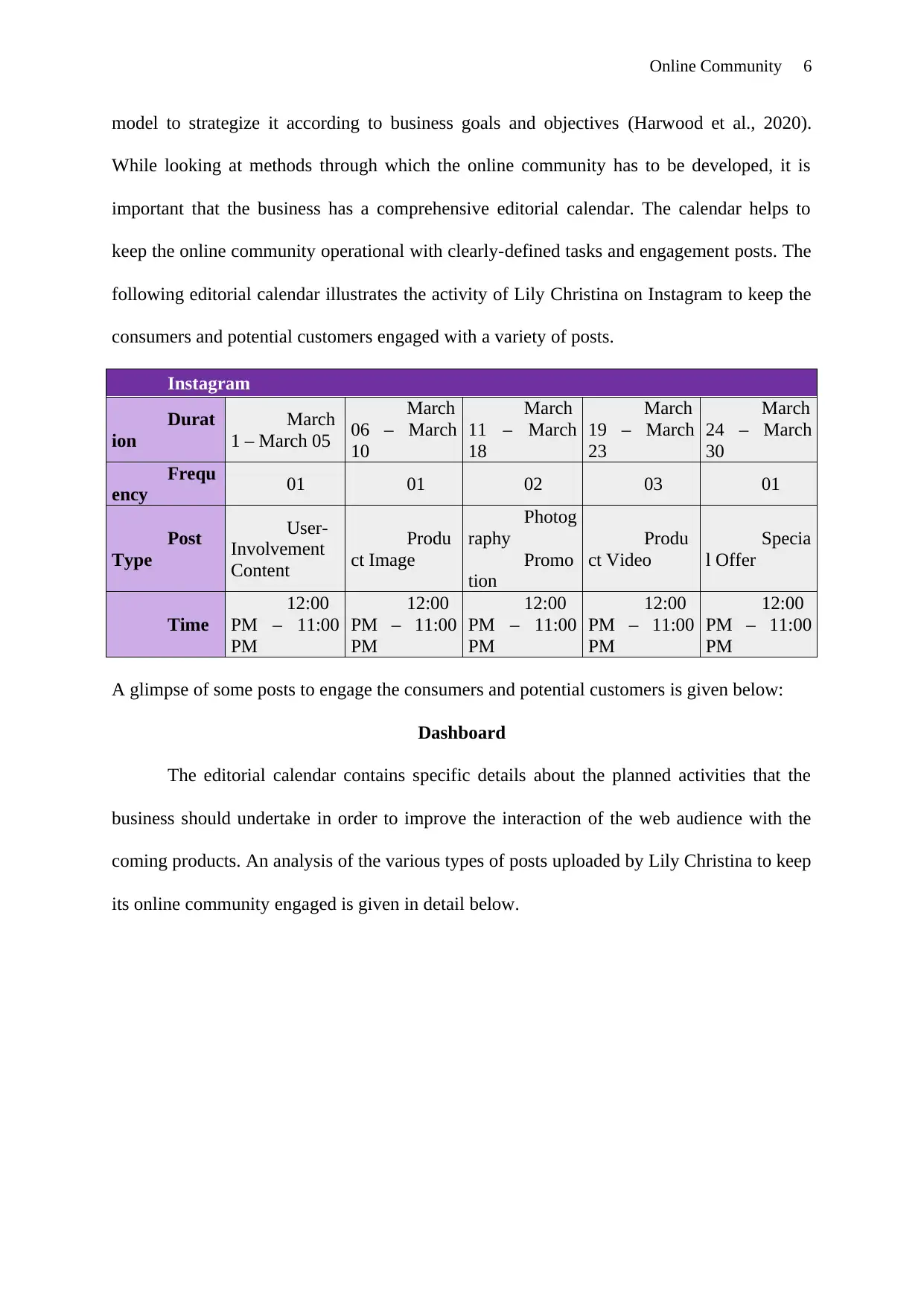
Online Community 6
model to strategize it according to business goals and objectives (Harwood et al., 2020).
While looking at methods through which the online community has to be developed, it is
important that the business has a comprehensive editorial calendar. The calendar helps to
keep the online community operational with clearly-defined tasks and engagement posts. The
following editorial calendar illustrates the activity of Lily Christina on Instagram to keep the
consumers and potential customers engaged with a variety of posts.
Instagram
Durat
ion
March
1 – March 05
March
06 – March
10
March
11 – March
18
March
19 – March
23
March
24 – March
30
Frequ
ency 01 01 02 03 01
Post
Type
User-
Involvement
Content
Produ
ct Image
Photog
raphy
Promo
tion
Produ
ct Video
Specia
l Offer
Time
12:00
PM – 11:00
PM
12:00
PM – 11:00
PM
12:00
PM – 11:00
PM
12:00
PM – 11:00
PM
12:00
PM – 11:00
PM
A glimpse of some posts to engage the consumers and potential customers is given below:
Dashboard
The editorial calendar contains specific details about the planned activities that the
business should undertake in order to improve the interaction of the web audience with the
coming products. An analysis of the various types of posts uploaded by Lily Christina to keep
its online community engaged is given in detail below.
model to strategize it according to business goals and objectives (Harwood et al., 2020).
While looking at methods through which the online community has to be developed, it is
important that the business has a comprehensive editorial calendar. The calendar helps to
keep the online community operational with clearly-defined tasks and engagement posts. The
following editorial calendar illustrates the activity of Lily Christina on Instagram to keep the
consumers and potential customers engaged with a variety of posts.
Durat
ion
March
1 – March 05
March
06 – March
10
March
11 – March
18
March
19 – March
23
March
24 – March
30
Frequ
ency 01 01 02 03 01
Post
Type
User-
Involvement
Content
Produ
ct Image
Photog
raphy
Promo
tion
Produ
ct Video
Specia
l Offer
Time
12:00
PM – 11:00
PM
12:00
PM – 11:00
PM
12:00
PM – 11:00
PM
12:00
PM – 11:00
PM
12:00
PM – 11:00
PM
A glimpse of some posts to engage the consumers and potential customers is given below:
Dashboard
The editorial calendar contains specific details about the planned activities that the
business should undertake in order to improve the interaction of the web audience with the
coming products. An analysis of the various types of posts uploaded by Lily Christina to keep
its online community engaged is given in detail below.
⊘ This is a preview!⊘
Do you want full access?
Subscribe today to unlock all pages.

Trusted by 1+ million students worldwide
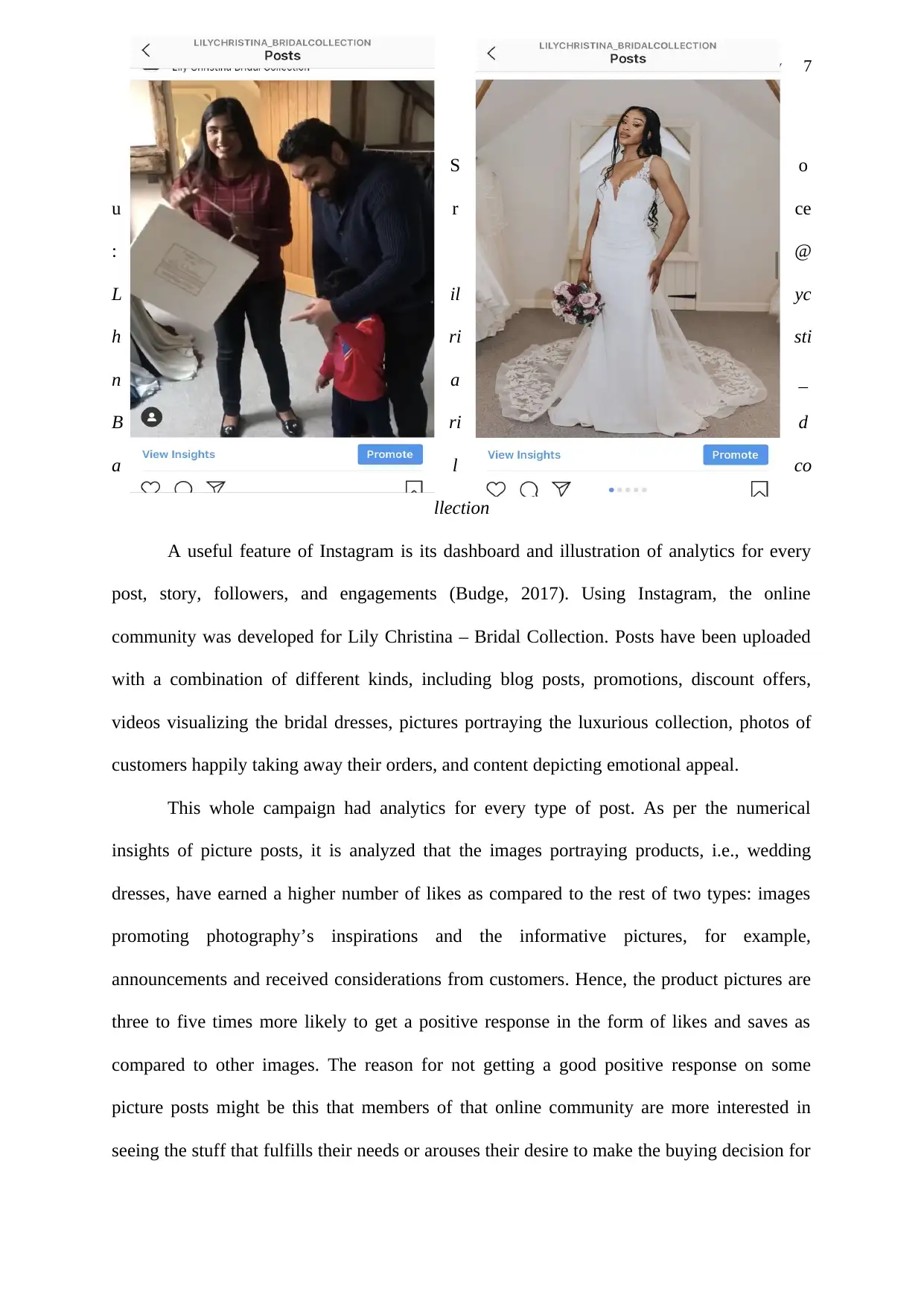
Online Community 7
S o
u r ce
: @
L il yc
h ri sti
n a _
B ri d
a l co
llection
A useful feature of Instagram is its dashboard and illustration of analytics for every
post, story, followers, and engagements (Budge, 2017). Using Instagram, the online
community was developed for Lily Christina – Bridal Collection. Posts have been uploaded
with a combination of different kinds, including blog posts, promotions, discount offers,
videos visualizing the bridal dresses, pictures portraying the luxurious collection, photos of
customers happily taking away their orders, and content depicting emotional appeal.
This whole campaign had analytics for every type of post. As per the numerical
insights of picture posts, it is analyzed that the images portraying products, i.e., wedding
dresses, have earned a higher number of likes as compared to the rest of two types: images
promoting photography’s inspirations and the informative pictures, for example,
announcements and received considerations from customers. Hence, the product pictures are
three to five times more likely to get a positive response in the form of likes and saves as
compared to other images. The reason for not getting a good positive response on some
picture posts might be this that members of that online community are more interested in
seeing the stuff that fulfills their needs or arouses their desire to make the buying decision for
S o
u r ce
: @
L il yc
h ri sti
n a _
B ri d
a l co
llection
A useful feature of Instagram is its dashboard and illustration of analytics for every
post, story, followers, and engagements (Budge, 2017). Using Instagram, the online
community was developed for Lily Christina – Bridal Collection. Posts have been uploaded
with a combination of different kinds, including blog posts, promotions, discount offers,
videos visualizing the bridal dresses, pictures portraying the luxurious collection, photos of
customers happily taking away their orders, and content depicting emotional appeal.
This whole campaign had analytics for every type of post. As per the numerical
insights of picture posts, it is analyzed that the images portraying products, i.e., wedding
dresses, have earned a higher number of likes as compared to the rest of two types: images
promoting photography’s inspirations and the informative pictures, for example,
announcements and received considerations from customers. Hence, the product pictures are
three to five times more likely to get a positive response in the form of likes and saves as
compared to other images. The reason for not getting a good positive response on some
picture posts might be this that members of that online community are more interested in
seeing the stuff that fulfills their needs or arouses their desire to make the buying decision for
Paraphrase This Document
Need a fresh take? Get an instant paraphrase of this document with our AI Paraphraser
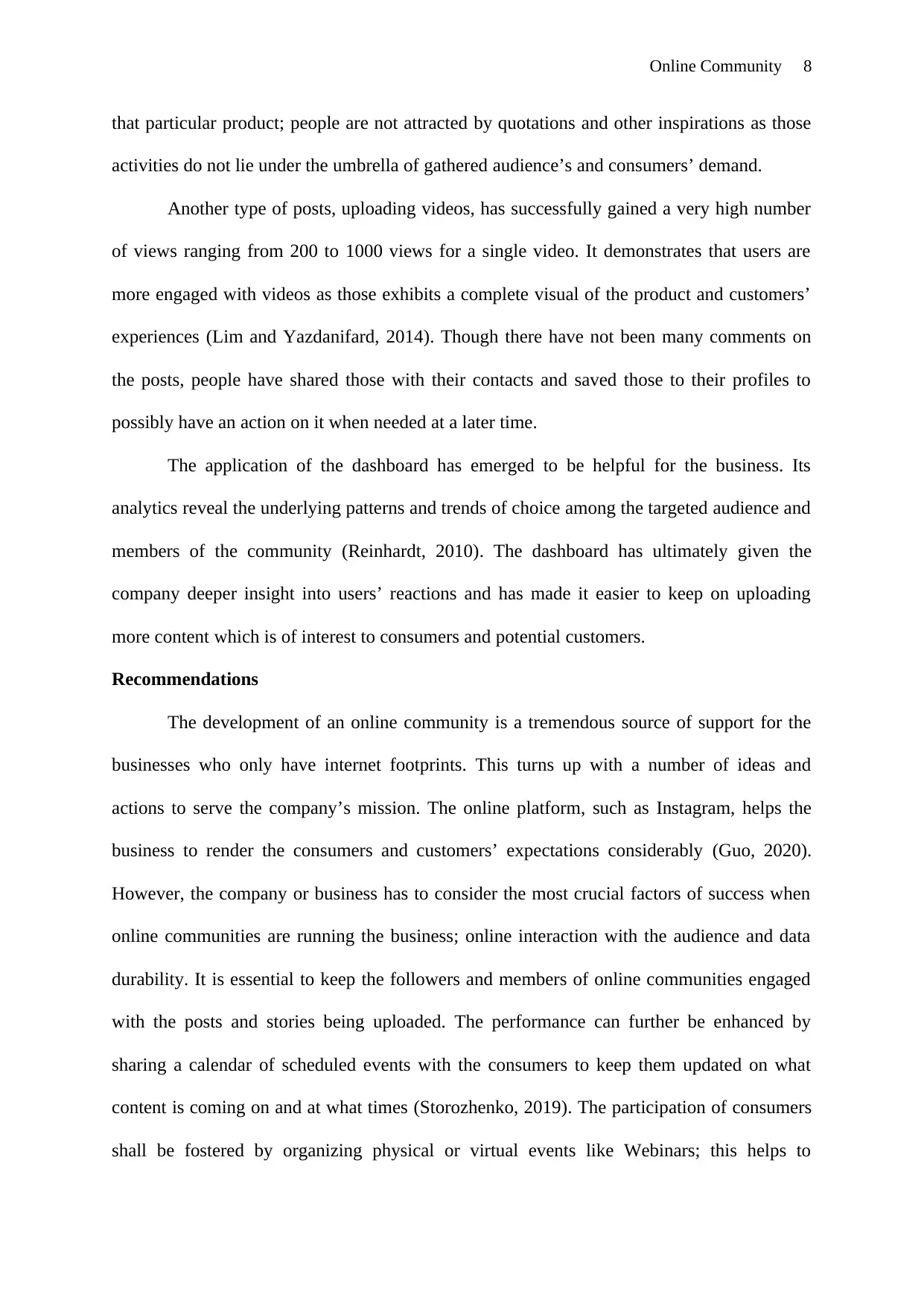
Online Community 8
that particular product; people are not attracted by quotations and other inspirations as those
activities do not lie under the umbrella of gathered audience’s and consumers’ demand.
Another type of posts, uploading videos, has successfully gained a very high number
of views ranging from 200 to 1000 views for a single video. It demonstrates that users are
more engaged with videos as those exhibits a complete visual of the product and customers’
experiences (Lim and Yazdanifard, 2014). Though there have not been many comments on
the posts, people have shared those with their contacts and saved those to their profiles to
possibly have an action on it when needed at a later time.
The application of the dashboard has emerged to be helpful for the business. Its
analytics reveal the underlying patterns and trends of choice among the targeted audience and
members of the community (Reinhardt, 2010). The dashboard has ultimately given the
company deeper insight into users’ reactions and has made it easier to keep on uploading
more content which is of interest to consumers and potential customers.
Recommendations
The development of an online community is a tremendous source of support for the
businesses who only have internet footprints. This turns up with a number of ideas and
actions to serve the company’s mission. The online platform, such as Instagram, helps the
business to render the consumers and customers’ expectations considerably (Guo, 2020).
However, the company or business has to consider the most crucial factors of success when
online communities are running the business; online interaction with the audience and data
durability. It is essential to keep the followers and members of online communities engaged
with the posts and stories being uploaded. The performance can further be enhanced by
sharing a calendar of scheduled events with the consumers to keep them updated on what
content is coming on and at what times (Storozhenko, 2019). The participation of consumers
shall be fostered by organizing physical or virtual events like Webinars; this helps to
that particular product; people are not attracted by quotations and other inspirations as those
activities do not lie under the umbrella of gathered audience’s and consumers’ demand.
Another type of posts, uploading videos, has successfully gained a very high number
of views ranging from 200 to 1000 views for a single video. It demonstrates that users are
more engaged with videos as those exhibits a complete visual of the product and customers’
experiences (Lim and Yazdanifard, 2014). Though there have not been many comments on
the posts, people have shared those with their contacts and saved those to their profiles to
possibly have an action on it when needed at a later time.
The application of the dashboard has emerged to be helpful for the business. Its
analytics reveal the underlying patterns and trends of choice among the targeted audience and
members of the community (Reinhardt, 2010). The dashboard has ultimately given the
company deeper insight into users’ reactions and has made it easier to keep on uploading
more content which is of interest to consumers and potential customers.
Recommendations
The development of an online community is a tremendous source of support for the
businesses who only have internet footprints. This turns up with a number of ideas and
actions to serve the company’s mission. The online platform, such as Instagram, helps the
business to render the consumers and customers’ expectations considerably (Guo, 2020).
However, the company or business has to consider the most crucial factors of success when
online communities are running the business; online interaction with the audience and data
durability. It is essential to keep the followers and members of online communities engaged
with the posts and stories being uploaded. The performance can further be enhanced by
sharing a calendar of scheduled events with the consumers to keep them updated on what
content is coming on and at what times (Storozhenko, 2019). The participation of consumers
shall be fostered by organizing physical or virtual events like Webinars; this helps to
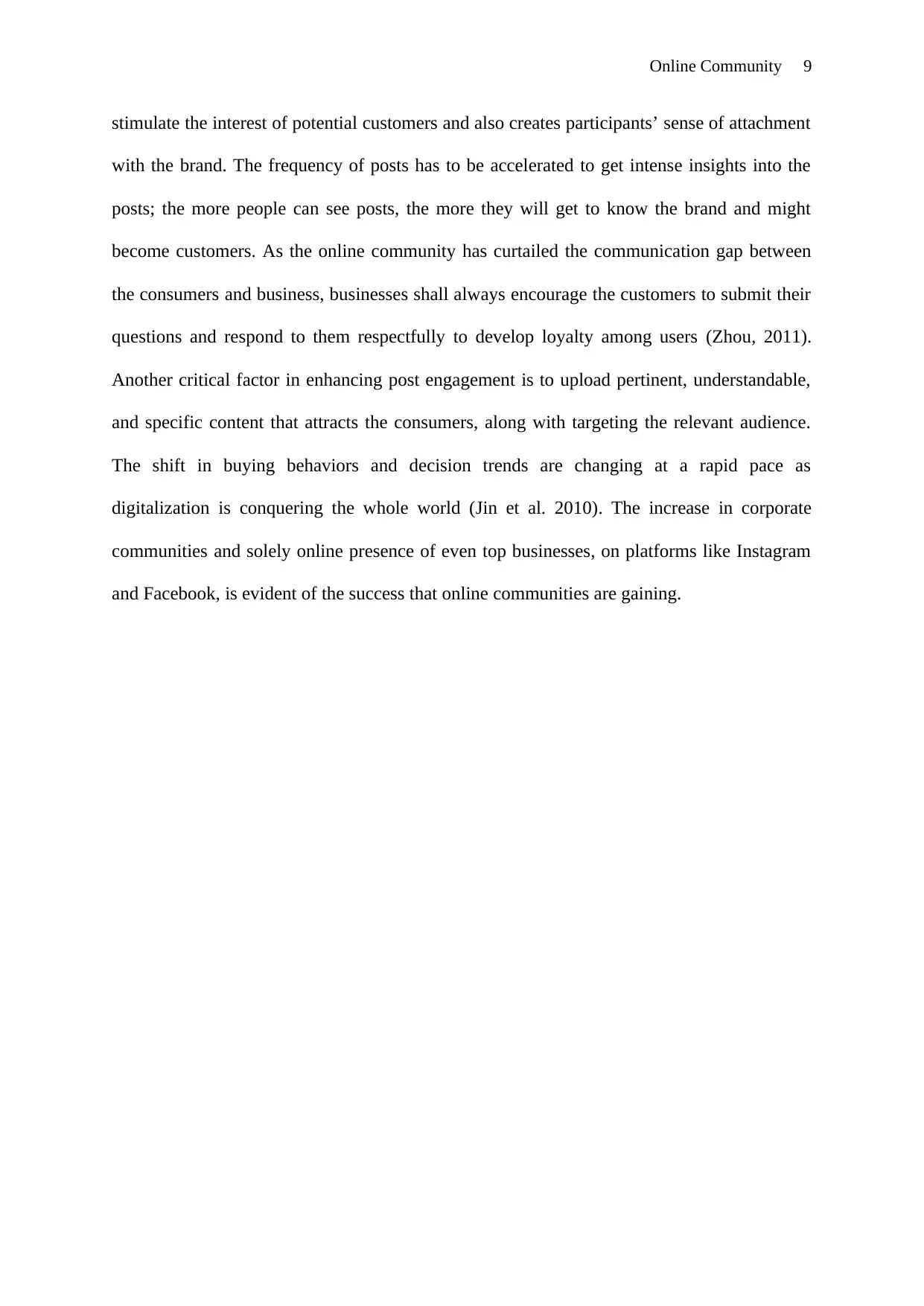
Online Community 9
stimulate the interest of potential customers and also creates participants’ sense of attachment
with the brand. The frequency of posts has to be accelerated to get intense insights into the
posts; the more people can see posts, the more they will get to know the brand and might
become customers. As the online community has curtailed the communication gap between
the consumers and business, businesses shall always encourage the customers to submit their
questions and respond to them respectfully to develop loyalty among users (Zhou, 2011).
Another critical factor in enhancing post engagement is to upload pertinent, understandable,
and specific content that attracts the consumers, along with targeting the relevant audience.
The shift in buying behaviors and decision trends are changing at a rapid pace as
digitalization is conquering the whole world (Jin et al. 2010). The increase in corporate
communities and solely online presence of even top businesses, on platforms like Instagram
and Facebook, is evident of the success that online communities are gaining.
stimulate the interest of potential customers and also creates participants’ sense of attachment
with the brand. The frequency of posts has to be accelerated to get intense insights into the
posts; the more people can see posts, the more they will get to know the brand and might
become customers. As the online community has curtailed the communication gap between
the consumers and business, businesses shall always encourage the customers to submit their
questions and respond to them respectfully to develop loyalty among users (Zhou, 2011).
Another critical factor in enhancing post engagement is to upload pertinent, understandable,
and specific content that attracts the consumers, along with targeting the relevant audience.
The shift in buying behaviors and decision trends are changing at a rapid pace as
digitalization is conquering the whole world (Jin et al. 2010). The increase in corporate
communities and solely online presence of even top businesses, on platforms like Instagram
and Facebook, is evident of the success that online communities are gaining.
⊘ This is a preview!⊘
Do you want full access?
Subscribe today to unlock all pages.

Trusted by 1+ million students worldwide
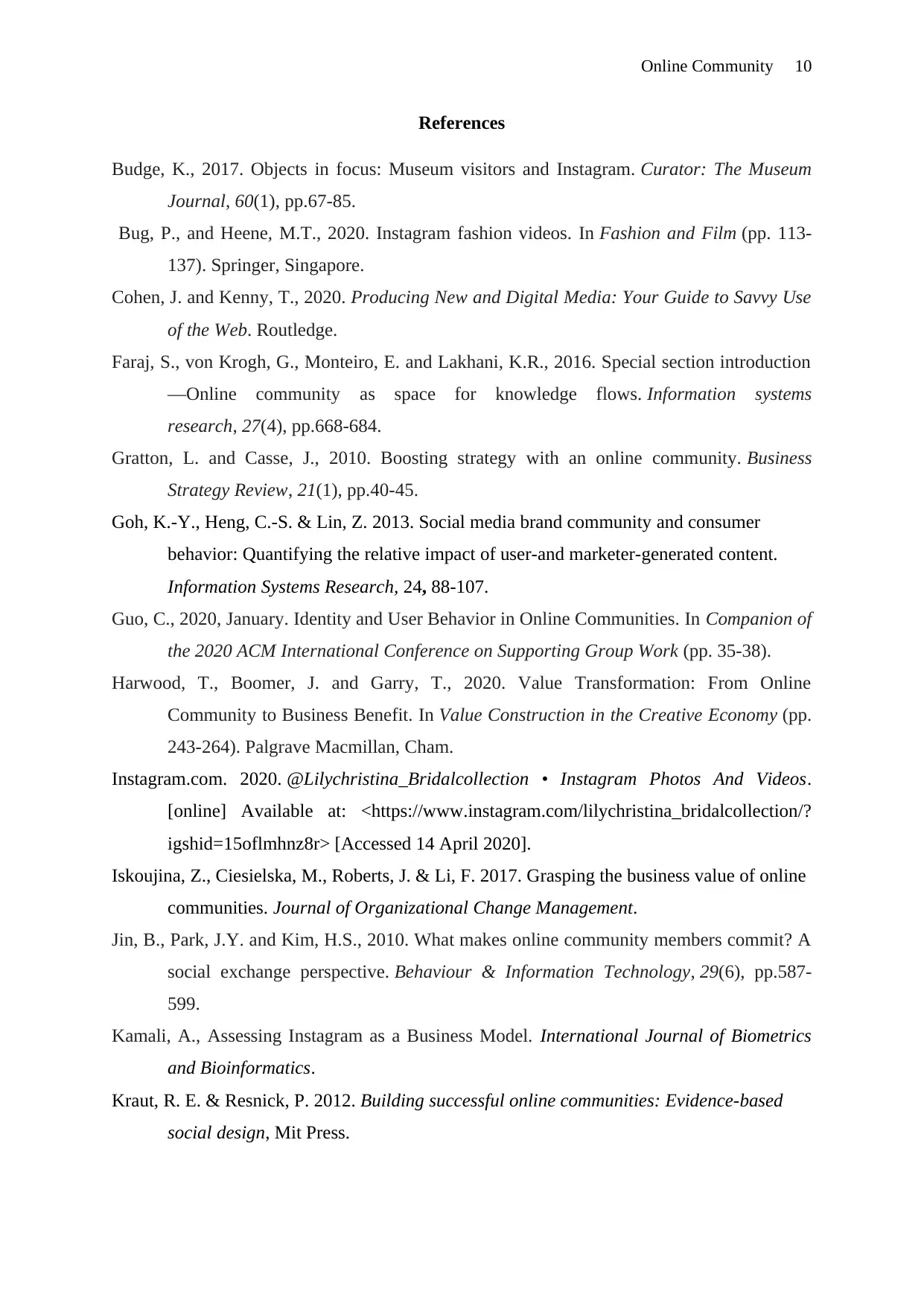
Online Community 10
References
Budge, K., 2017. Objects in focus: Museum visitors and Instagram. Curator: The Museum
Journal, 60(1), pp.67-85.
Bug, P., and Heene, M.T., 2020. Instagram fashion videos. In Fashion and Film (pp. 113-
137). Springer, Singapore.
Cohen, J. and Kenny, T., 2020. Producing New and Digital Media: Your Guide to Savvy Use
of the Web. Routledge.
Faraj, S., von Krogh, G., Monteiro, E. and Lakhani, K.R., 2016. Special section introduction
—Online community as space for knowledge flows. Information systems
research, 27(4), pp.668-684.
Gratton, L. and Casse, J., 2010. Boosting strategy with an online community. Business
Strategy Review, 21(1), pp.40-45.
Goh, K.-Y., Heng, C.-S. & Lin, Z. 2013. Social media brand community and consumer
behavior: Quantifying the relative impact of user-and marketer-generated content.
Information Systems Research, 24, 88-107.
Guo, C., 2020, January. Identity and User Behavior in Online Communities. In Companion of
the 2020 ACM International Conference on Supporting Group Work (pp. 35-38).
Harwood, T., Boomer, J. and Garry, T., 2020. Value Transformation: From Online
Community to Business Benefit. In Value Construction in the Creative Economy (pp.
243-264). Palgrave Macmillan, Cham.
Instagram.com. 2020. @Lilychristina_Bridalcollection • Instagram Photos And Videos.
[online] Available at: <https://www.instagram.com/lilychristina_bridalcollection/?
igshid=15oflmhnz8r> [Accessed 14 April 2020].
Iskoujina, Z., Ciesielska, M., Roberts, J. & Li, F. 2017. Grasping the business value of online
communities. Journal of Organizational Change Management.
Jin, B., Park, J.Y. and Kim, H.S., 2010. What makes online community members commit? A
social exchange perspective. Behaviour & Information Technology, 29(6), pp.587-
599.
Kamali, A., Assessing Instagram as a Business Model. International Journal of Biometrics
and Bioinformatics.
Kraut, R. E. & Resnick, P. 2012. Building successful online communities: Evidence-based
social design, Mit Press.
References
Budge, K., 2017. Objects in focus: Museum visitors and Instagram. Curator: The Museum
Journal, 60(1), pp.67-85.
Bug, P., and Heene, M.T., 2020. Instagram fashion videos. In Fashion and Film (pp. 113-
137). Springer, Singapore.
Cohen, J. and Kenny, T., 2020. Producing New and Digital Media: Your Guide to Savvy Use
of the Web. Routledge.
Faraj, S., von Krogh, G., Monteiro, E. and Lakhani, K.R., 2016. Special section introduction
—Online community as space for knowledge flows. Information systems
research, 27(4), pp.668-684.
Gratton, L. and Casse, J., 2010. Boosting strategy with an online community. Business
Strategy Review, 21(1), pp.40-45.
Goh, K.-Y., Heng, C.-S. & Lin, Z. 2013. Social media brand community and consumer
behavior: Quantifying the relative impact of user-and marketer-generated content.
Information Systems Research, 24, 88-107.
Guo, C., 2020, January. Identity and User Behavior in Online Communities. In Companion of
the 2020 ACM International Conference on Supporting Group Work (pp. 35-38).
Harwood, T., Boomer, J. and Garry, T., 2020. Value Transformation: From Online
Community to Business Benefit. In Value Construction in the Creative Economy (pp.
243-264). Palgrave Macmillan, Cham.
Instagram.com. 2020. @Lilychristina_Bridalcollection • Instagram Photos And Videos.
[online] Available at: <https://www.instagram.com/lilychristina_bridalcollection/?
igshid=15oflmhnz8r> [Accessed 14 April 2020].
Iskoujina, Z., Ciesielska, M., Roberts, J. & Li, F. 2017. Grasping the business value of online
communities. Journal of Organizational Change Management.
Jin, B., Park, J.Y. and Kim, H.S., 2010. What makes online community members commit? A
social exchange perspective. Behaviour & Information Technology, 29(6), pp.587-
599.
Kamali, A., Assessing Instagram as a Business Model. International Journal of Biometrics
and Bioinformatics.
Kraut, R. E. & Resnick, P. 2012. Building successful online communities: Evidence-based
social design, Mit Press.
Paraphrase This Document
Need a fresh take? Get an instant paraphrase of this document with our AI Paraphraser
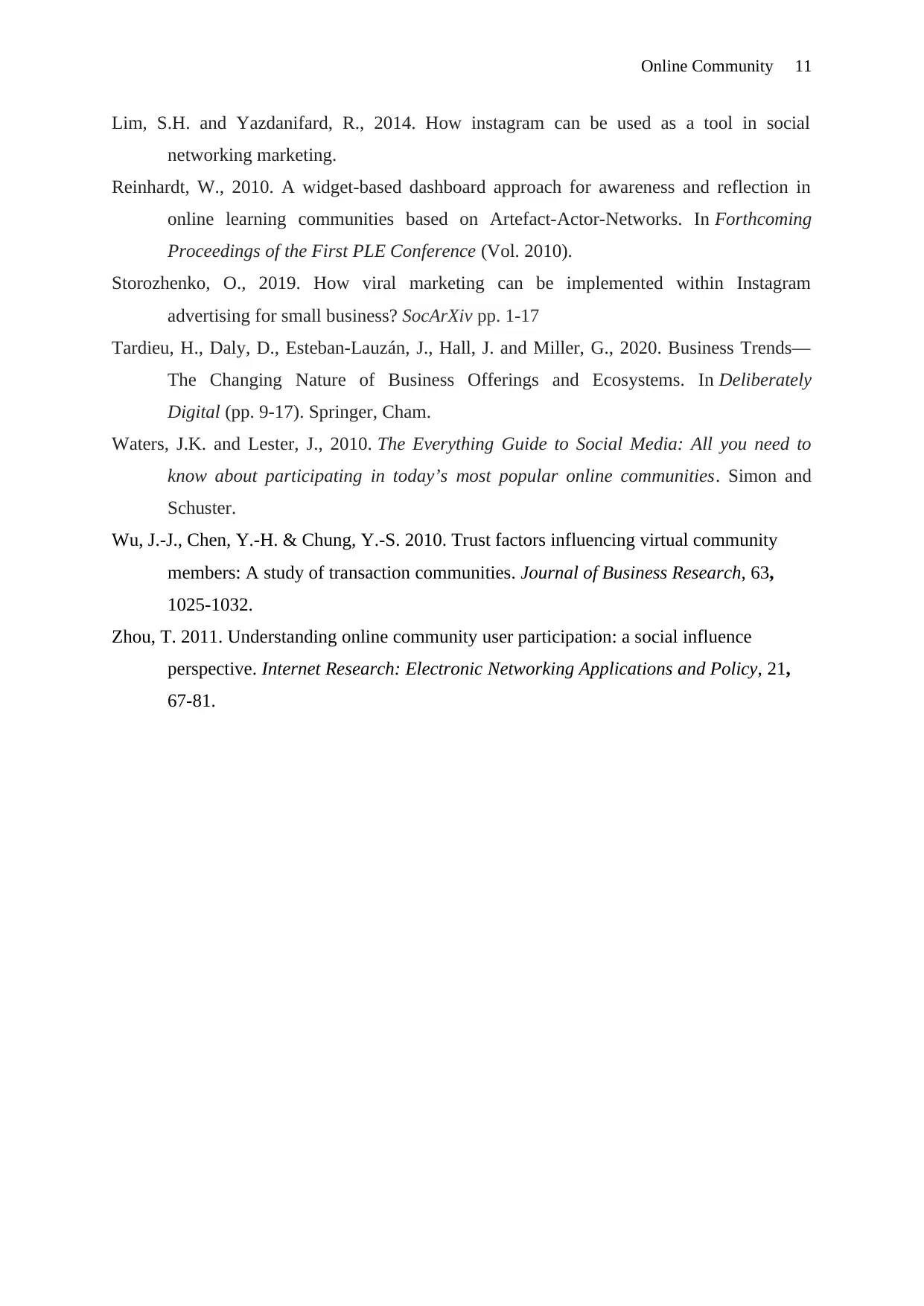
Online Community 11
Lim, S.H. and Yazdanifard, R., 2014. How instagram can be used as a tool in social
networking marketing.
Reinhardt, W., 2010. A widget-based dashboard approach for awareness and reflection in
online learning communities based on Artefact-Actor-Networks. In Forthcoming
Proceedings of the First PLE Conference (Vol. 2010).
Storozhenko, O., 2019. How viral marketing can be implemented within Instagram
advertising for small business? SocArXiv pp. 1-17
Tardieu, H., Daly, D., Esteban-Lauzán, J., Hall, J. and Miller, G., 2020. Business Trends—
The Changing Nature of Business Offerings and Ecosystems. In Deliberately
Digital (pp. 9-17). Springer, Cham.
Waters, J.K. and Lester, J., 2010. The Everything Guide to Social Media: All you need to
know about participating in today’s most popular online communities. Simon and
Schuster.
Wu, J.-J., Chen, Y.-H. & Chung, Y.-S. 2010. Trust factors influencing virtual community
members: A study of transaction communities. Journal of Business Research, 63,
1025-1032.
Zhou, T. 2011. Understanding online community user participation: a social influence
perspective. Internet Research: Electronic Networking Applications and Policy, 21,
67-81.
Lim, S.H. and Yazdanifard, R., 2014. How instagram can be used as a tool in social
networking marketing.
Reinhardt, W., 2010. A widget-based dashboard approach for awareness and reflection in
online learning communities based on Artefact-Actor-Networks. In Forthcoming
Proceedings of the First PLE Conference (Vol. 2010).
Storozhenko, O., 2019. How viral marketing can be implemented within Instagram
advertising for small business? SocArXiv pp. 1-17
Tardieu, H., Daly, D., Esteban-Lauzán, J., Hall, J. and Miller, G., 2020. Business Trends—
The Changing Nature of Business Offerings and Ecosystems. In Deliberately
Digital (pp. 9-17). Springer, Cham.
Waters, J.K. and Lester, J., 2010. The Everything Guide to Social Media: All you need to
know about participating in today’s most popular online communities. Simon and
Schuster.
Wu, J.-J., Chen, Y.-H. & Chung, Y.-S. 2010. Trust factors influencing virtual community
members: A study of transaction communities. Journal of Business Research, 63,
1025-1032.
Zhou, T. 2011. Understanding online community user participation: a social influence
perspective. Internet Research: Electronic Networking Applications and Policy, 21,
67-81.
1 out of 11
Related Documents
Your All-in-One AI-Powered Toolkit for Academic Success.
+13062052269
info@desklib.com
Available 24*7 on WhatsApp / Email
![[object Object]](/_next/static/media/star-bottom.7253800d.svg)
Unlock your academic potential
Copyright © 2020–2025 A2Z Services. All Rights Reserved. Developed and managed by ZUCOL.





